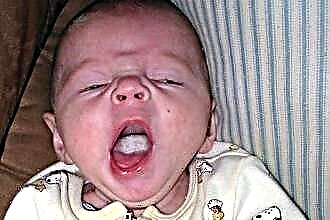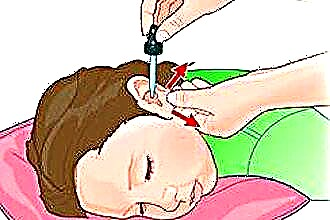Infectious inflammation of the respiratory system is almost always accompanied by irritation of the mucous membranes, hyperemia and pain. How to determine a red throat in a small child or not? Newborns cannot independently inform their parents about the presence of a problem, older children often ignore unpleasant symptoms until the pain begins to radiate to the teeth, ears, neck, etc.
 It is possible to determine the presence of pathological processes in the ENT organs by the behavior of the child and the indirect manifestations of the disease. If you suspect inflammation of the mucous membranes of the pharynx, you need to conduct an independent examination of the oral cavity.
It is possible to determine the presence of pathological processes in the ENT organs by the behavior of the child and the indirect manifestations of the disease. If you suspect inflammation of the mucous membranes of the pharynx, you need to conduct an independent examination of the oral cavity.
In case of detection of swelling, hypertrophy of the palatine tonsils and redness, you should seek the help of a pediatrician.
The timely passage of drug therapy prevents the development of complications and the progression of pathogenic flora.
Sore throat in newborns
It is most difficult to diagnose ENT disease in newborns, since they cannot complain of discomfort in the throat, malaise and other manifestations of the disease. How do you know if your child has a sore throat? Catarrhal inflammation of the airways leads to irritation of the nociceptors, as a result of which the child feels pain at the site of localization of the pathogenic flora.
The presence of pathological changes in the tissues of the pharynx in infants is most often signaled by the following signs:
- capriciousness;
- deterioration in sleep;
- refusal to eat;
- profuse salivation;
- cry when swallowing saliva.
The above symptoms are a good reason for examining the oropharynx of a newborn. According to the condition of the mucous membranes of the throat and palatine tonsils, it is possible to determine the presence or absence of inflammatory processes.
Associated symptoms
 The development of septic inflammation in the airways in most cases is evidenced by the manifestation of a characteristic symptomatic picture. Pathogens poison the child's body with metabolites, as a result of which general signs of intoxication appear. If young children are sick, the presence of pathological processes in the respiratory organs is most often signaled by:
The development of septic inflammation in the airways in most cases is evidenced by the manifestation of a characteristic symptomatic picture. Pathogens poison the child's body with metabolites, as a result of which general signs of intoxication appear. If young children are sick, the presence of pathological processes in the respiratory organs is most often signaled by:
- temperature increase;
- nasal congestion;
- runny nose;
- hypersalivation;
- dry or moist cough;
- an increase in regional lymph nodes;
- wheezing in the lungs;
- increased sleepiness;
- labored breathing.
If it is painful for a young child to swallow, it is likely that he will refuse to eat and drink. When characteristic symptoms of the development of a respiratory disease appear, a visit to a specialist cannot be postponed. Delayed treatment of infectious inflammation can cause local complications.
Sore throat in children from 2 years of age
Most children aged 1.5-2 years are able to express themselves and in the event of discomfort in the throat, inform their parents about it. If the child has rhinitis and a barking cough, you should ask him about his health. As a rule, with the development of septic inflammation in the respiratory organs, patients complain of:
- sore throat and sore throat;
- headache;
- general weakness and malaise;
- difficulty swallowing;
- ear congestion;
- nausea;
- loss of appetite.
 Self-medication can lead to the development of paratonsillar abscess, tracheitis and other diseases.
Self-medication can lead to the development of paratonsillar abscess, tracheitis and other diseases.
In most cases, the causative agents of an infectious disease in children are viruses: adenoviruses, coronaviruses, herpes viruses, rhinoviruses, etc. However, about a third of all ENT diseases are provoked by the bacterial flora.
The choice of drugs of etiotropic action is possible only after an accurate diagnosis, which is carried out on the basis of microbiological culture data from the pharynx.
Oropharyngeal examination technique
If you suspect the development of ARVI and other colds in a child, it is necessary to examine the oropharynx. By local manifestations, one can judge the intensity of pathological processes, the localization of the pathogenic flora and the state of the mucous membranes of the ENT organs. How can you tell if a child has a red throat or not?
You will need a small flashlight, a medical spatula, or a spoon with a flat handle to visually examine your mouth. To assess the condition of the mucous membranes of the oropharynx, you should:
- ask the patient to open his mouth wide and take a deep breath;
- at the same time, the soft palate will reflexively rise up, which will determine the state of the posterior pharyngeal wall;
- press a little on the root of the tongue to assess the size and condition of the tonsils;
- "Illuminate" the palatine arches with a flashlight and determine the presence of tissue edema.
Inspection results
How to decipher the results of the examination of the oropharynx? By the nature of the inflammatory processes, the degree of hyperemia and tissue edema, one can judge the patient's condition and the need for his hospitalization. The following local manifestations may indicate the presence of pathological changes in the mucous membranes of the oral cavity:
- redness of the walls of the throat is the result of septic or aseptic inflammation of the ciliated epithelium and lymphoid tissues of the pharynx;
- swelling of the mucous membranes is a sign of a violation of the microcirculation of blood and lymph in the foci of inflammation;
- white plaque on the root of the tongue and the back of the pharynx is a symptom that signals the presence of bacterial inflammation in the tissues;
 an increase in the palatine tonsils is a sign of septic inflammation of the airways;
an increase in the palatine tonsils is a sign of septic inflammation of the airways;- white dots on the tonsils - a symptom of the development of lacunar or follicular tonsillitis;
- runoff of mucus along the back of the throat is a sign of the development of inflammatory processes not only in the pharynx, but also in the nasal passages.
If most of the above signs are identified, it is advisable to seek help from an otolaryngologist. Depending on the etiology of the disease, the specialist will prescribe drugs of symptomatic or etiotropic action.
List of diseases
If, after undergoing drug therapy, the child continues to be ill, this may indicate an incorrect diagnosis.
Symptoms of general intoxication and discomfort when swallowing can be a consequence of the development of such ENT pathologies as:
- rubella;
- pharyngitis;
- measles;
- diphtheria;
- scarlet fever;
- flu;
- tonsillitis;
- tracheitis.
In case of deterioration of the patient's well-being, a microbiological analysis of biomaterials taken from the pharynx should be done. If the disease is provoked by viruses, antiviral drugs will help to eliminate inflammation, if by microbes - antibiotics, if by a fungus - antimycotics, etc. To eliminate pain and swelling in the airways, symptomatic drugs allow. Anesthetics and anti-allergic drugs eliminate local manifestations, which makes the course of the disease easier.
When to see a doctor?
 Many parents mistakenly believe they can cope with the “common cold” on their own. However, irrational use of medications can significantly worsen the well-being of the child and cause dangerous complications.
Many parents mistakenly believe they can cope with the “common cold” on their own. However, irrational use of medications can significantly worsen the well-being of the child and cause dangerous complications.
To prevent negative consequences, you need to make an appointment with the pediatrician if you find the following signs:
- hyperthermia for 3-4 days;
- nausea and vomiting;
- labored breathing;
- sore throat radiating to the ear;
- enlargement of the submandibular lymph nodes;
- diarrhea and black circles under the eyes;
- hemoptysis and confusion.
Important! Late treatment of ARVI often causes the appearance of encephalopathic syndrome in children under 5 years of age.
It should be understood that respiratory diseases in infants do not always develop acutely. After infection of the ENT organs, the body temperature may not rise for 3-4 days. However, newborns with the development of ARVI most often refuse to eat or spit up immediately after feeding.

 an increase in the palatine tonsils is a sign of septic inflammation of the airways;
an increase in the palatine tonsils is a sign of septic inflammation of the airways;

